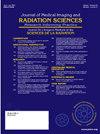Ready for the Big Time: Provincial Formalization of an APRT(T) Class of Practice
IF 1.3
Q3 RADIOLOGY, NUCLEAR MEDICINE & MEDICAL IMAGING
Journal of Medical Imaging and Radiation Sciences
Pub Date : 2025-05-01
DOI:10.1016/j.jmir.2025.101957
引用次数: 0
Abstract
Purpose/Aim
The growth of advanced practice in radiation therapy requires pan-Canadian infrastructure to standardize, streamline, and incentivize related roles across the country. A national certification model that certifies advanced radiation therapy practice has been in place since 2017, administered by the Canadian Association of Medical Radiation Technologists (CAMRT). This confers the protected title of Advanced Practice Registered Technologist (Therapy), or APRT(T), on those meeting the requirements. The next logical step in solidifying safe and standardized advanced practice is to define a separate regulatory class for APRT(T)s in provinces where regulation of medical radiation technology (MRT) professions exists. The CAMRT convened a task group of radiation therapists with expertise in advanced practice and issues of self-regulation in Ontario, Alberta, British Columbia (BC), and Nova Scotia, to prepare the way for future action on extended class practice for APRT(T)s.
Methods/Process
The CAMRT APRT(T) Regulation & Legislation Task Group set out to accomplish three tasks: 1) Define the specific tasks and responsibilities that distinguish advanced practice from standard practice in radiation therapy, as it relates to formal regulated scopes of practice in each Ontario, Alberta, and Nova Scotia, and future regulation in BC. 2) Enlist the preliminary support of provincial regulatory bodies and other stakeholders for the Task Group work to define a separate regulatory class for APRT(T)s 3) Map provincial legislative and regulatory processes and prepare evidence and materials to formalize the new APRT(T) role Using the national APRT(T) competency profile, provincial legislation that defines controlled acts, restricted activities, and profession-specific regulations (depending on the province), and an inventory of medical directives and delegations held by currently certified APRT(T)s, the Task Group identified the areas where legislative and regulatory change would be required to formalize an APRT(T) class of practice. Following relevant guidance, documentation was prepared to initiate the process to create a separate class in each province.
Results or Benefits/Challenges
Recognizing a separate class of practice for APRT(T) will support consistent and sustainable implementation of this important role. APRT(T)s will be able to practice autonomously and to full scope without additional delegations, medical directives or support structures. A separate category of self-regulated practice may also incentivize centres to invest in new models of care that involve APRT(T)s. More importantly, in the interest of public safety, it will ensure that engagement in an advanced scope of radiation therapy practice is restricted to those formally confirmed to have the requisite knowledge, skills, and judgement through national certification. The differences in provincial legislation and regulation of practice, the modest number of APRT(T)s currently practicing in the country, and the ongoing challenges in socializing the relevant radiation medicine professional communities to the nature of advanced practice all present challenges that require expert attention to ensure the success of this initiative.
Conclusions/Impact
A collaborative and concerted approach to creating an advanced class of license for APRT(T)s where MRT practice is self-regulated in Canada will support efforts to advance this important role in cancer care.
为大时代做好准备:APRT(T)实践课程的省级正规化
目的/目的放射治疗高级实践的增长需要泛加拿大的基础设施来规范、简化和激励全国各地的相关角色。自2017年以来,由加拿大医疗放射技师协会(CAMRT)管理的国家认证模式已经实施,该模式认证了先进的放射治疗实践。这授予那些符合要求的高级执业注册技师(治疗)或APRT(T)的受保护头衔。巩固安全和标准化先进实践的下一个合乎逻辑的步骤是在存在医疗辐射技术(MRT)专业监管的省份为APRT(T)定义一个单独的监管类别。CAMRT召集了一个由安大略省、阿尔伯塔省、不列颠哥伦比亚省和新斯科舍省具有高级实践和自我监管问题专业知识的放射治疗师组成的任务小组,为未来扩大APRT(T)班级实践的行动做好准备。CAMRT APRT(T)法规&;立法工作组着手完成三个任务:1)定义区分放射治疗高级实践与标准实践的具体任务和责任,因为它涉及安大略省,阿尔伯塔省和新斯科舍省的正式规范实践范围,以及不列颠哥伦比亚省的未来监管。2)争取省级监管机构和其他利益相关者的初步支持,为任务小组的工作定义一个单独的APRT(T)监管类别3)绘制省级立法和监管流程,并准备证据和材料,以正式确定新的APRT(T)角色。使用国家APRT(T)能力概况、定义受控行为、限制活动和专业特定法规的省级立法(取决于各省);以及目前获得认证的APRT(T)的医疗指示和授权清单,工作队确定了需要进行立法和监管改革的领域,以正式确定APRT(T)的执业类别。根据相关指导,编写了文件,以启动在每个省创建单独班级的进程。结果或益处/挑战承认单独的APRT(T)实践类别将支持这一重要角色的一致和可持续实施。APRT(T)将能够在没有额外授权、医疗指示或支持结构的情况下自主和充分开展工作。一种独立的自我监管的实践也可能激励中心投资于涉及APRT(T)的新型护理模式。更重要的是,为了公共安全的利益,它将确保从事高级范围的放射治疗实践仅限于那些通过国家认证正式确认具有必要知识、技能和判断力的人。各省立法和实践监管的差异,目前在国内执业的APRT(T)数量有限,以及相关放射医学专业社区与高级实践性质的社会化所面临的持续挑战,都需要专家的关注,以确保这一举措的成功。结论/影响通过合作和协调的方式为APRT(T)创建高级许可,使MRT实践在加拿大自我监管,将支持推进这一在癌症治疗中的重要作用。
本文章由计算机程序翻译,如有差异,请以英文原文为准。
求助全文
约1分钟内获得全文
求助全文
来源期刊

Journal of Medical Imaging and Radiation Sciences
RADIOLOGY, NUCLEAR MEDICINE & MEDICAL IMAGING-
CiteScore
2.30
自引率
11.10%
发文量
231
审稿时长
53 days
期刊介绍:
Journal of Medical Imaging and Radiation Sciences is the official peer-reviewed journal of the Canadian Association of Medical Radiation Technologists. This journal is published four times a year and is circulated to approximately 11,000 medical radiation technologists, libraries and radiology departments throughout Canada, the United States and overseas. The Journal publishes articles on recent research, new technology and techniques, professional practices, technologists viewpoints as well as relevant book reviews.
 求助内容:
求助内容: 应助结果提醒方式:
应助结果提醒方式:


